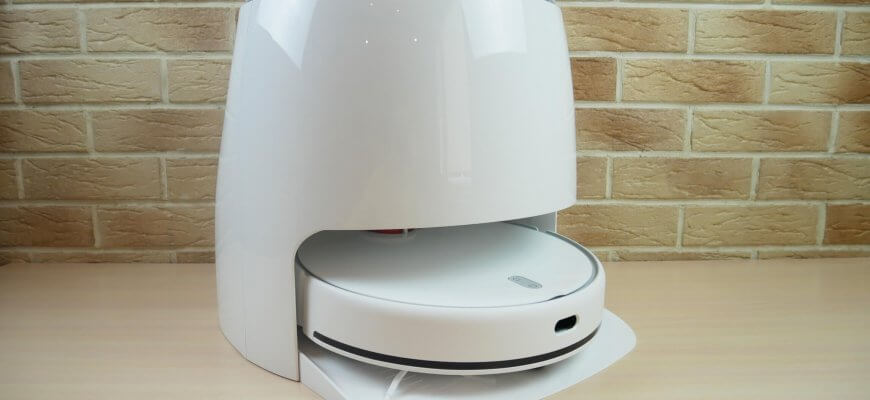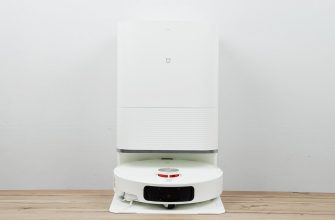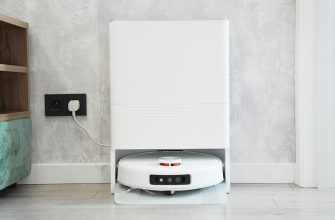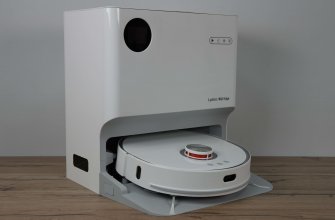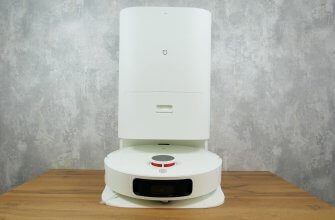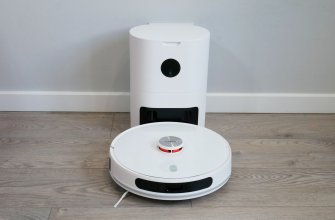Hello everyone! We continue testing new robot vacuum cleaners with a self-cleaning mopping station and in this review will focus on the new Xiaomi Mijia Self-Cleaning Sweeping Mopping Robot MJSTP, which was released on sale at the end of 2021 and is actively sold on Aliexpress, where actually this order was placed. This robot vacuum cleaner is able not only to automatically wash the mopping pad at the station during cleaning, but also to lift it up when driving on carpets. So in one cleaning cycle, Mijia Self-Cleaning Robot Vacuum-Mop, this is its second name, can simultaneously vacuum and mop the floor, leaving the carpets dry and clean. But that’s not all. When moving, the platform with a mopping pad makes progressive movements, which should help to wipe off dirt from the floor more effectively. Next, I will review and test this device in detail. After that I will express my own opinion on how well the functionality is implemented and whether the robot vacuum cleaner is worth its price. The price at the time of preparation of this review is $520-650, which is justified for the declared features and functions. Let’s go!
- Equipment
- Design
- Specifications
- Functionality
- Testing
- Navigation
- Suction power
- Dry cleaning on laminate
- Carpet cleaning
- Mopping (rubbing off the dirt)
- Mopping (rubbing off difficult stains)
- Mopping and carpets
- Simultaneous dry and wet cleaning
- The quality of self-cleaning
- Passage of obstacles
- Passage of dark surfaces
- Noise level
- Some Observations
- Summing up
Equipment
The robot vacuum cleaner came in such a big box:
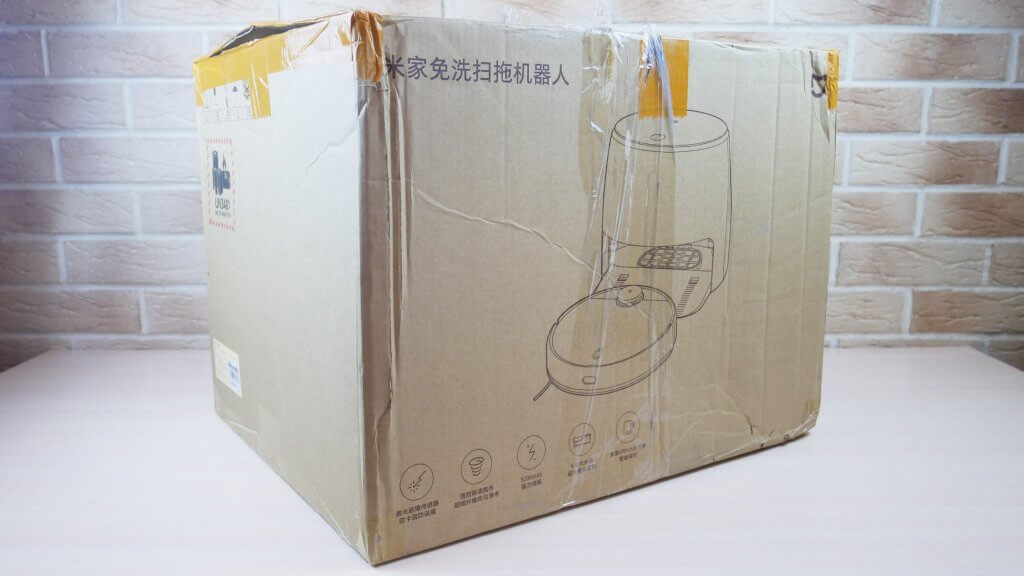
In addition to the robot and the station, the delivery set includes:
- Power adapter with Chinese plug.
- Another power adapter with European plug.
- Instruction manual in Chinese.
- Spare microfiber cloth. And one is already installed on the robot.
- Spare side brush.
- And a cleaning tool for the robot vacuum cleaner.

We see that the set is not basic. There are even spare accessories included. But it would be better to put a spare HEPA filter instead of a side brush. It wears out much faster. But thanks for that too!
Design
Now let’s look at how the Xiaomi Mijia Self-Cleaning Robot Vacuum Mop MJSTP designed. Let’s start with the robot vacuum cleaner. It is made in white color, in round shape. Case height is 97 mm from the floor.

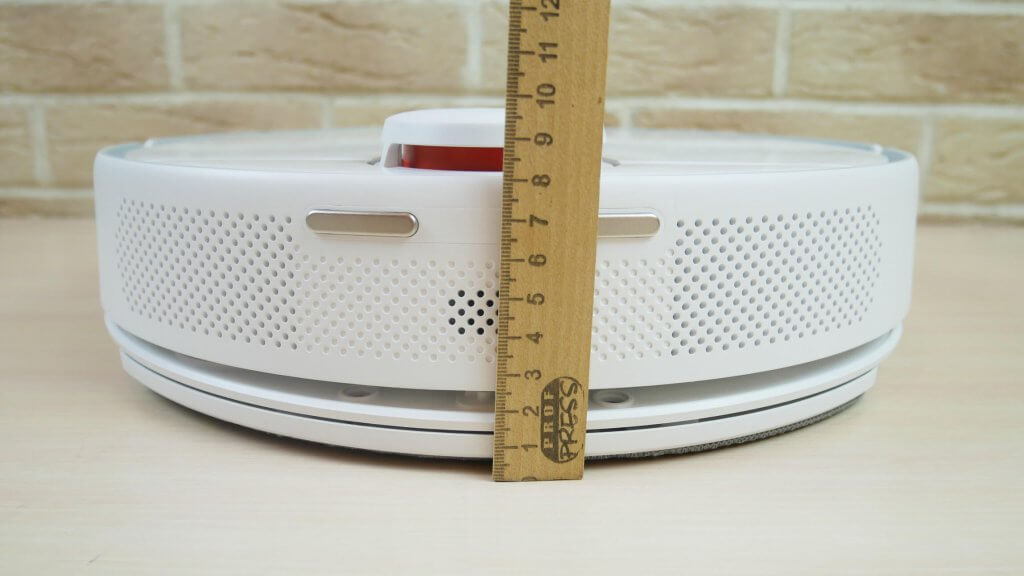
An obstacle detection sensor is located on the front mechanical bumper. There is no additional wall sensor. The charging terminals are located on the back part.
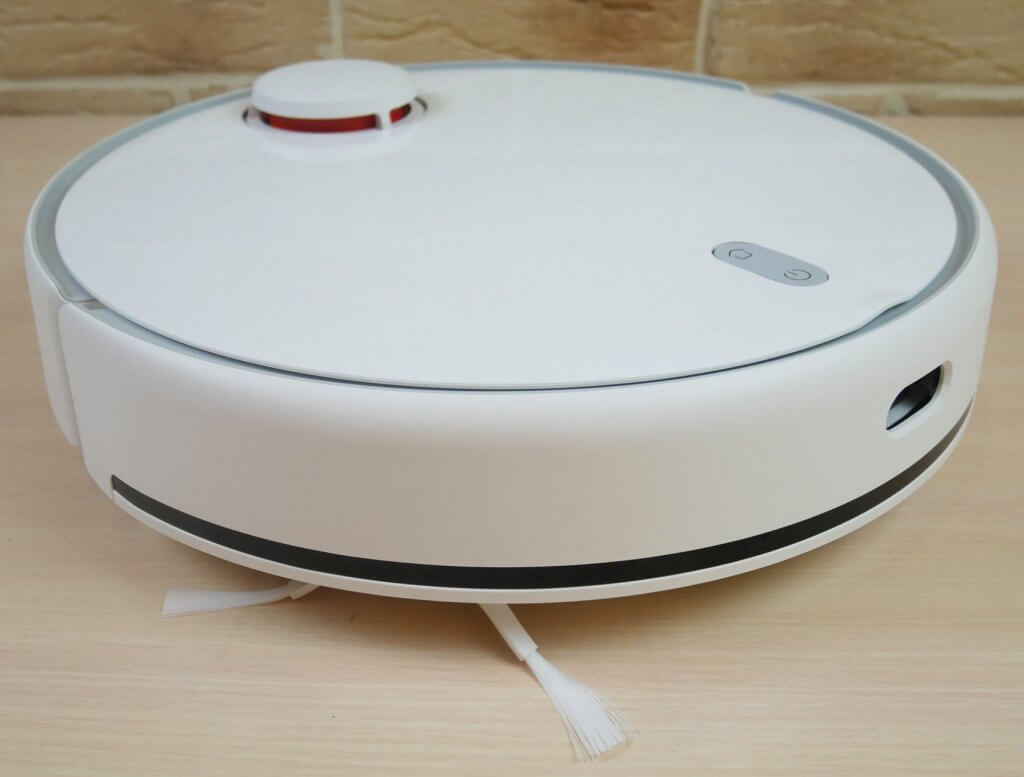
On top of the cover we see 2 mechanical control buttons: start / pause and forced return to the base for charging. Lidar is responsible for navigation. The lidar cover is spring-loaded, which protects the robot vacuum cleaner from getting stuck under furniture.
The dust collector is located under the top cover. Its capacity is not indicated anywhere, but in my case it could hold up to 450 grams of rice. So, we can say, most likely a dust collector` capacity is 450-500 ml. Filtration system based on mesh and HEPA filter.

Let’s see how the robot vacuum cleaner is arranged from bottom. It has 6 fall protection sensors. The platform for fastening the mopping pad is not removable, the mopping pad is held by Velcro and a groove. The water tank is not provided in this robot. By the way, the mopping pad itself is quite dense. 2-3 times denser than ordinary mopping pads, which Xiaomi robot vacuum cleaners are equipped with.
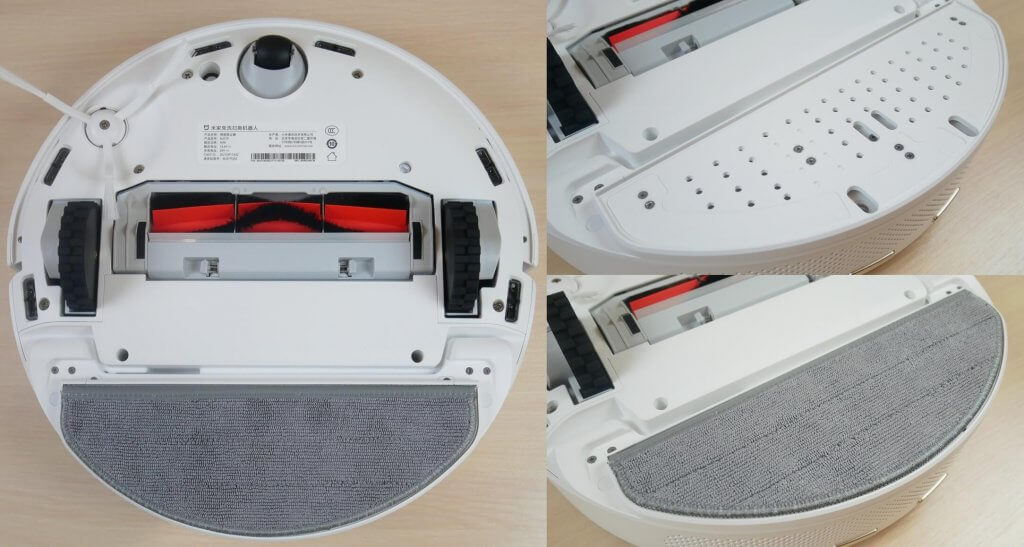
The central brush is bristly-petal. The pile is very dense. On both sides, the brush is disassembled for cleaning from wound hair and wool.
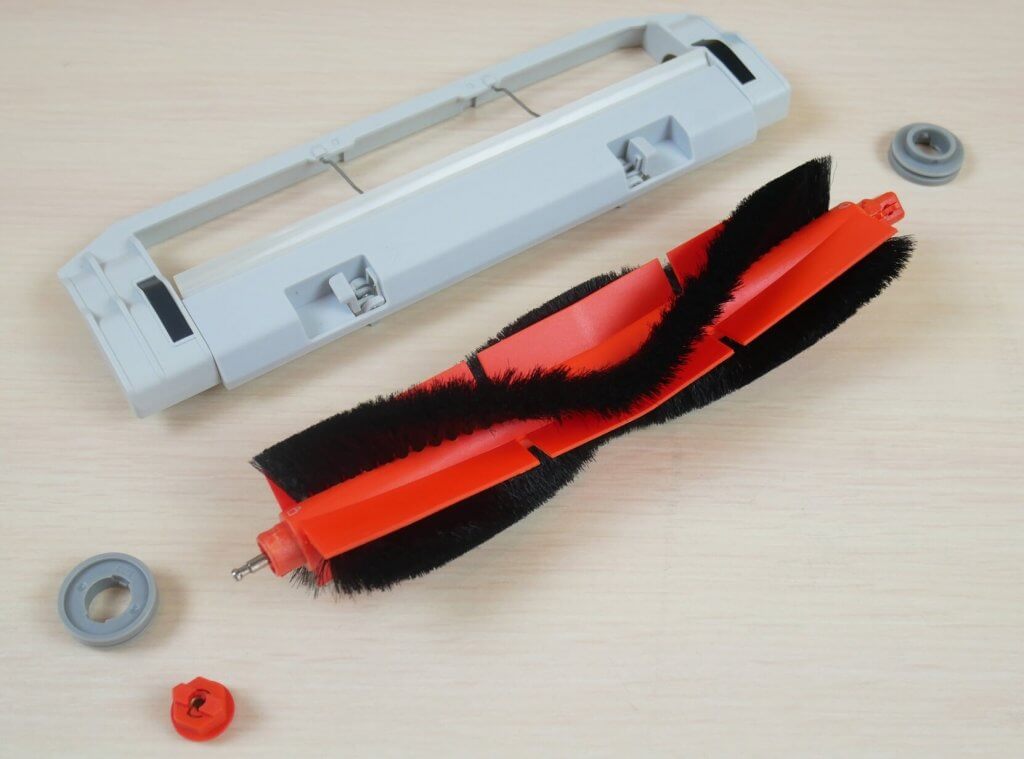
And here is an important point – an ultrasonic carpet recognition sensor is installed near the swivel roller. This is a plus. Considering all the above, the build quality of the Xiaomi Mijia Self-Cleaning Robot Vacuum Mop MJSTP is above average. There are no special remarks for this robot.
Let`s check how the station is designed. I can’t help but agree with one of my subscribers that visually it looks like a dry closet 😊 Not everyone gonna like it. In model Dreame Bot W10, the station looks a bit prettier, in my subjective opinion. The height of the station is 45 cm, but with the lid open, which is important to consider, the height reaches 72 cm.
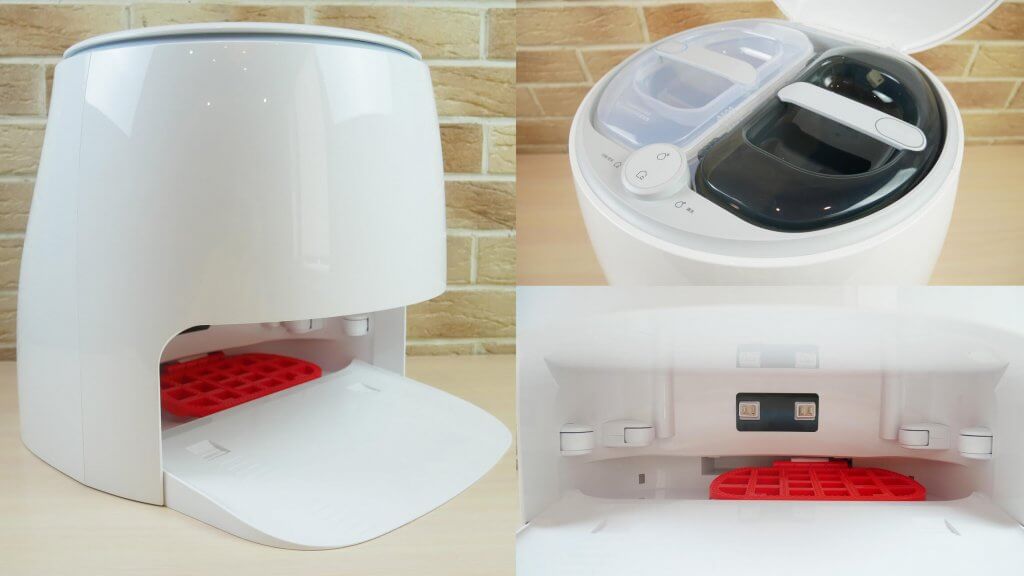
The station has two mechanical control buttons. Under the lid there are 2 tanks: for clean and dirty water. Their capacity is not indicated, but I weighed a full tank of clean water. The total weight came out 5 146 grams. So, each of the tanks holds approximately 4 liters of water, if poured to the maximum mark.
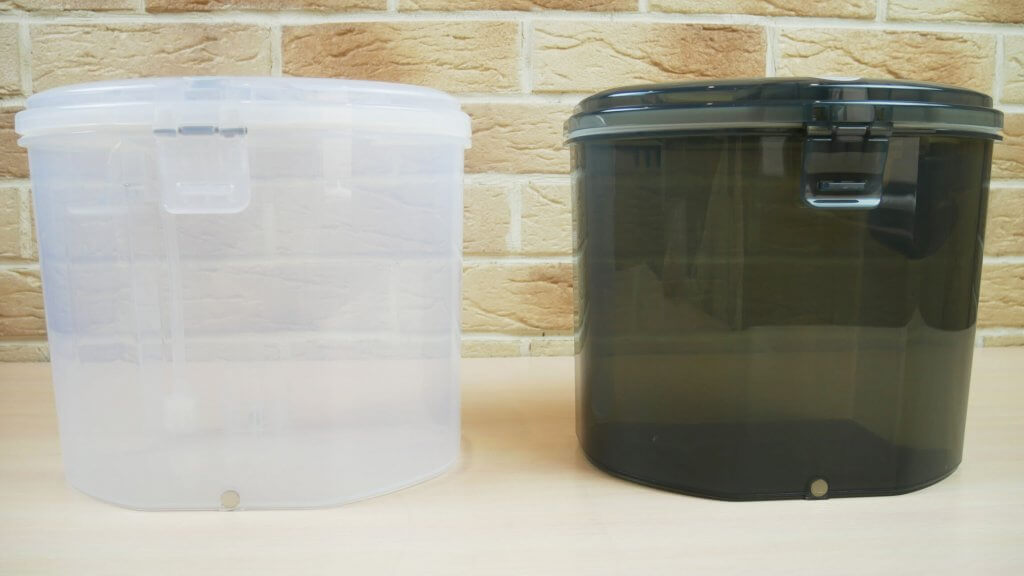
Inside the tank for clean water there is a tube for supplying water to the rinsing zone of the mopping pad. Inside the tank for dirty water we see a float, when triggered, a notification will appear in the application about the need to drain the dirty water from the tank.
As for the platform for the arrival of the robot, rollers are installed on the walls to help park inside the station, as well as a bright mechanism that cleans the mopping pad from the garbage it has collected. She moves left and right, scraping debris under the stream of water. The drain hole for dirty water is protected by such a plastic filter.
The big minus of this station is that it is not possible to remove the platform for washing with water, for example, in the sink, as is implemented in the Dreame Bot W10. Washing it – is another “pleasure” that I experienced after completing testing.
As a result, we can say, the robot is well-designed, unlike the station is.
Specifications
The main characteristics of Xiaomi Mijia Self-Cleaning Sweeping Mopping Robot MJSTP, declared by the manufacturer:
- Battery Li-Ion 5200 mAh.
- Suction power up to 2800 Pa.
- Operating time >120 min.
- Cleaning area >100 sq.m.
- Capacity of a dustbin ≈500 ml.
- Capacity of tanks for dirty and clean water (in the station) ≈ 4 l + 4 l.
- Passage of obstacles up to 20 mm.
- Robot dimensions: 353*96.5 mm.
- Station dimensions: 390*410*450 mm.
Operating time, cleaning area, not even the capacity of the dust collector and tanks in the station are indicated by the manufacturer anywhere. So I took the approximate values that I received during the tests.
Functionality
Let’s move on to an overview of the functions of Mijia Self-Cleaning Robot Vacuum-Mop. This robot vacuum cleaner is for the Chinese market. The international version is currently not on sale, so when connecting, you need to select the China region. The application interface will be in English, and the robot itself will speak Chinese. This is important to consider. Well, the application, in the best traditions of the Chinese versions of Xiaomi robots, is quiet slow, which can cause some inconvenience during operation.
On the main working panel, the robot vacuum cleaner builds a map of the room and automatically zones it into areas. By clicking on the desired rooms on the map, you can send the robot to clean these rooms. There is also a cleaning mode in selected areas and a local cleaning mode.
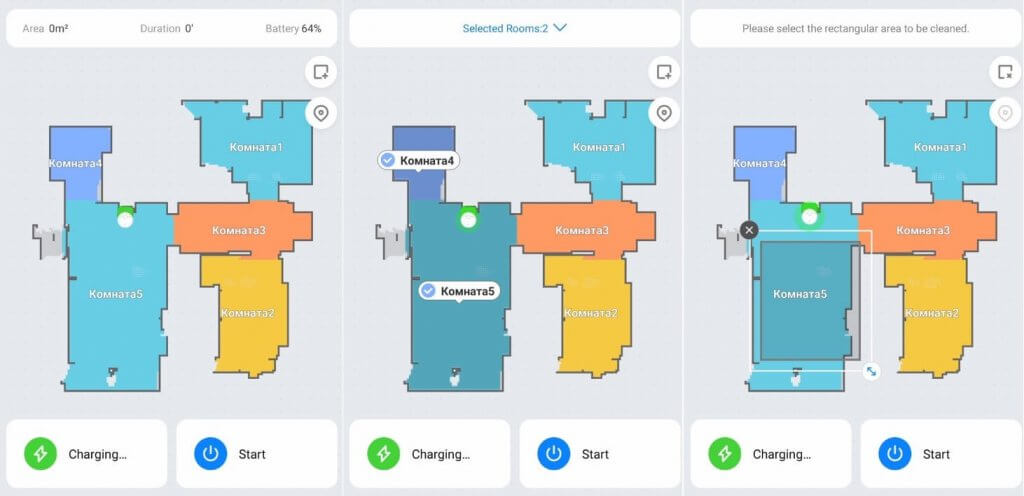
Under the map there are buttons for forced return of the robot to the station and start/pause. Below are the cleaning options. In normal mode, you can select the cleaning mode: dry only, dry and wet, and wet only. The suction power is also adjustable. There is no adjustment of the level of wetting of the mopping pad at the station yet. But you can flexibly adjust the cleaning parameters for each room: the number of passes by the robot (one or two), the type of cleaning and suction power. This is a plus!
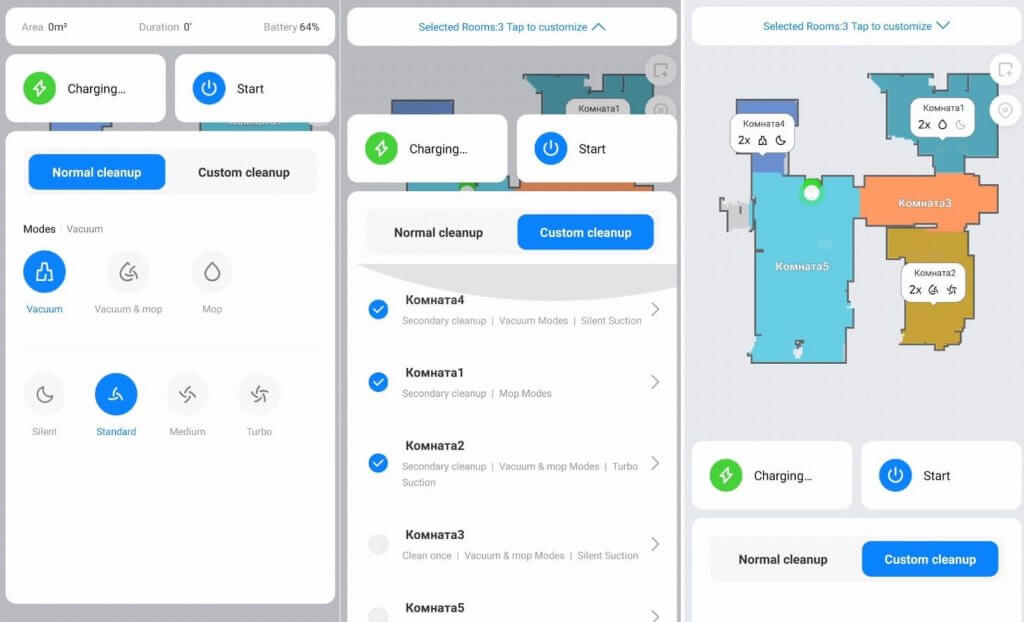
Let’s go to the settings section. The first in the list is the cleaning log. Next is the map manager, where you can select one of the saved maps in memory. This robot vacuum cleaner supports multi-maps. On the selected map, you can set virtual walls and restricted areas, and even separate restricted areas for the wet cleaning mode. In addition, you can edit the borders of rooms and give them a name. If necessary, you can reset the map, start the mopping pad rinse and dry function.
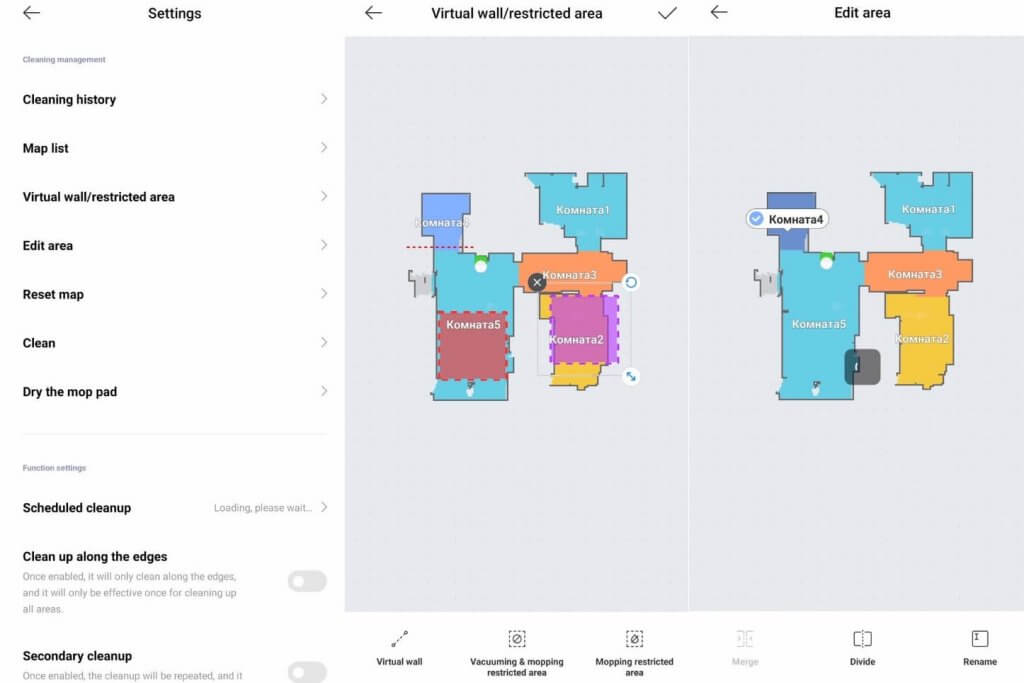
In the scheduled cleaning settings section, you can select days of the week, cleaning times, rooms, and also select individual cleaning settings for each room. This is a plus. The two sliders below are responsible for turning on the perimeter cleaning mode and double-passing the entire available area. There is also a “Do Not Disturb” mode at a given time and a function for quickly building a cleaning map. Below it is another slider – it is responsible for turning on the water sterilization mode in the station.
There are also sections where you can track the status of consumables, turn on the search for a robot by a sound signal, and configure additional cleaning options. I will focus on this section more detailed. It has a subsection with carpet cleaning settings. It contains features such as automatic power increase when driving on carpets, a carpet avoidance function, as well as the display of carpets on the map. Additionally, you can turn on and off voice alerts, adjust their volume and select the movement pattern of the robot vacuum cleaner in wet cleaning mode. To let it move in an S-shape, like most other robots. Or let it clean in an Y-shape, which allows you to better scrub the dirt from the floor. Well, below is the ability to calibrate the sensors on the robot and enable manual control. This is all the functionality of Mijia Self-Cleaning Robot Vacuum-Mop.
These features will be enough to automatically maintain cleanliness in the house. Additionally, it is worth noting that the robot is able to continue cleaning after recharging at the base.
Testing
Navigation
Let’s move on to the tests. First of all, let’s check the navigation of the Mijia Self-Cleaning Robot Vacuum-Mop in the obstacle room. So first robot crosses the entire area along the perimeter, and then with a snake moves. On the legs of the dryer and when overcoming thresholds, the mopping pad automatically lifts above the floor, which increases the robot’s passage ability. As a result, the robot did not get stuck on the legs of the dryer and was able to separately sweep around all the legs of the chair and the box. In the process of cleaning, it even drove into the station for rinsing of the mopping pad, because. the algorithm includes rinsing strictly every 10 sq.m. Test passed successfully!
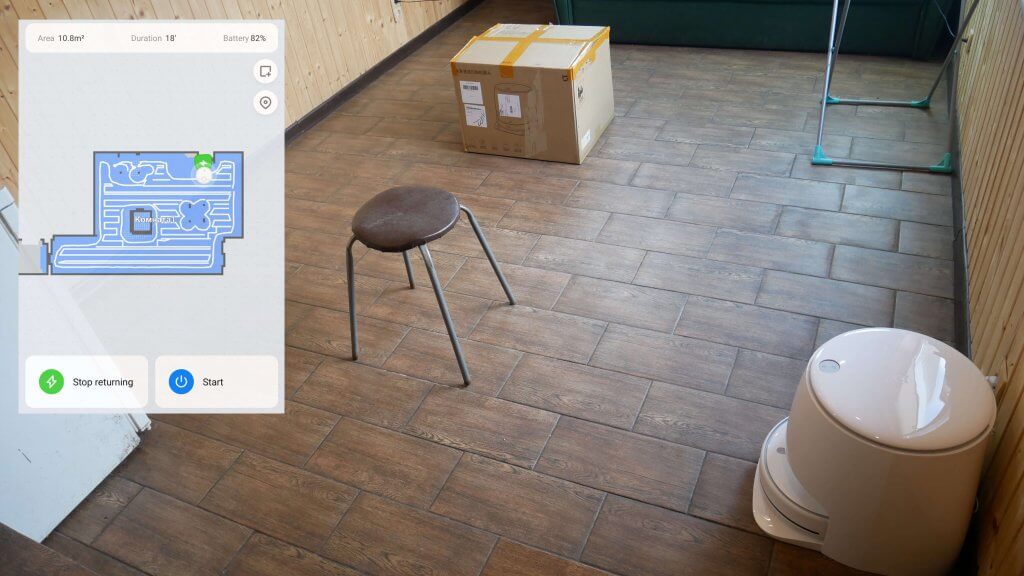
Navigation within the house is good, no questions. The robot cleans room after room, first along the perimeter, then with a snake moves. There are no uncleaned areas left. Test passed successfully!
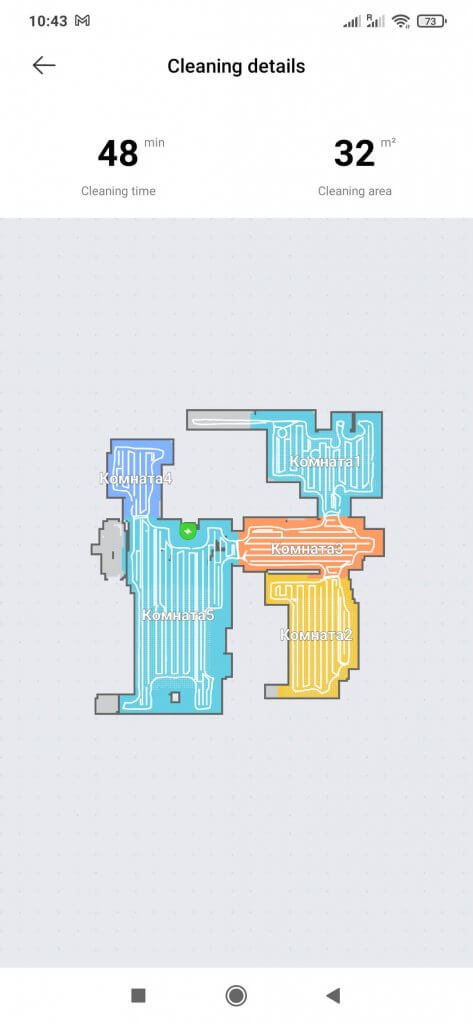
Suction power
But the suction power is a big question. The manufacturer declared as much as 2800 Pa, although in reality the robot could not suck out debris even from a 2 mm slot. The suction power is weak, this is the first serious remark about the robot.
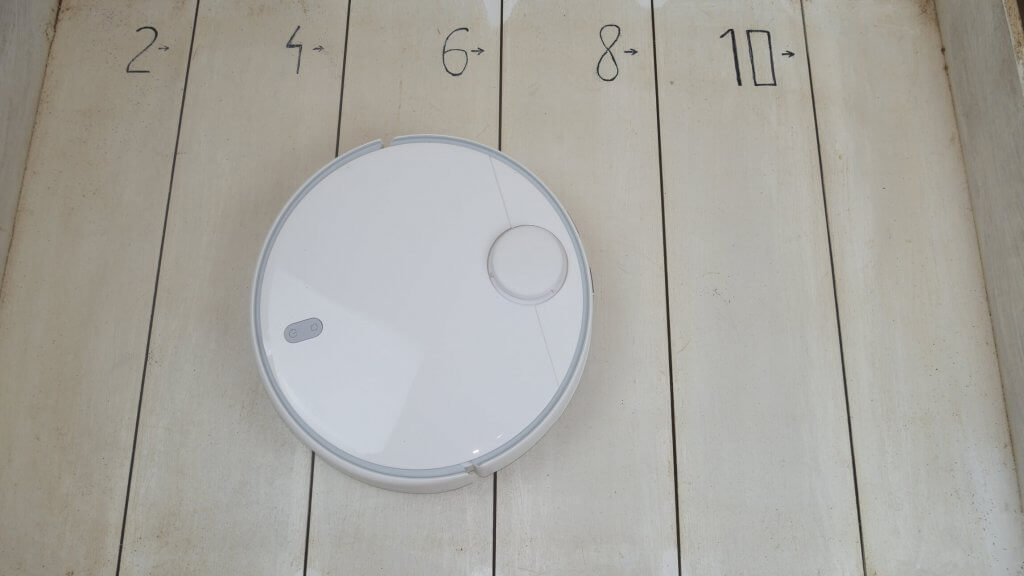
Dry cleaning on laminate
The quality of garbage collection on the laminate is high. The robot completely collected the garbage on the stand, leaving only a small part in the corners, due to the round shape. Some hair is wrapped around the central brush, but most of the debris is collected in the dust box. Test passed successfully!

Carpet cleaning
But the quality of carpet cleaning, in the best traditions of Mijia robot vacuum cleaners, is below average. Mijia Self-Cleaning Robot Vacuum-Mop does not clean carpets well from debris of different structure and this is important to consider.

Mopping (rubbing off the dirt)
There was a problem when testing the quality of dirt removal. Wet cleaning does not turn on if you manually move the robot to the right place, such as in my case, the stand. In order for the robot to wipe the floor, it must be launched from the station and cannot be moved. Otherwise, after restarting, he will want to return to the base to rinse mopping pads. I had to drag the station to the stand in order to at least somehow check whether the Mijia Self-Cleaning Robot Vacuum-Mop is capable of scrubbing dirt from the floor. We can say that yes, it can. It may not be perfect, but the quality of dirt removal is above average. Like most robots, it has a blind spot along the plinth, where a mopping pad does not reach. Well with several attempts and with an intermediate rinse of the mopping pad, the robot nevertheless wiped off most of the dirt in the cleaning area.

Mopping (rubbing off difficult stains)
But rubbing off complex dried spots is beyond his power at all. It’s not that he can’t scrub the sauce, even coffee stains are a big problem for it. The mopping pad is very weakly pressed against the floor and its movements do not in any way increase the efficiency of wiping off dirt. So it’s more of a marketing thing. The same Hobot Legee 7 is much more suitable for such tasks!

Mopping and carpets
As mentioned earlier, when driving on carpets, the robot vacuum cleaner automatically lifts the mopping pad, as does the Roborock S7. Therefore, the robot is able to fully wipe the floor and collect debris, leaving the carpets dry and clean.

But if necessary, you can turn on the carpet avoidance mode so that the robot does not run into them at all. This can be useful if the pile is very high and the lift height of the mopping pad over the carpet is insufficient.
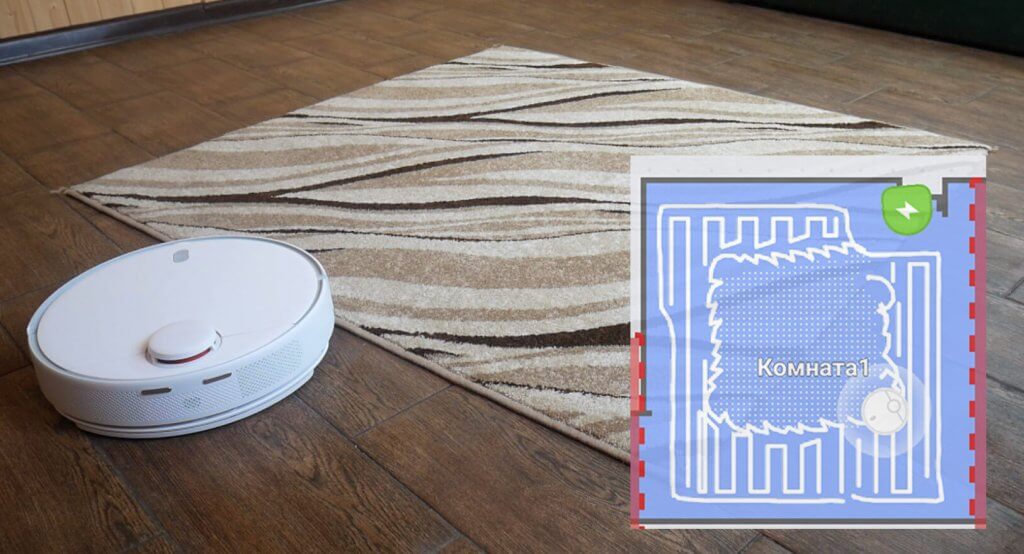
Simultaneous dry and wet cleaning
On the other hand, a big plus of Xiaomi Mijia MJSTP is that it can simultaneously vacuum and mop the floor while rinsing mopping pad during the cleaning cycle so that the cleaning quality is not lowering.

However, it’s bad that you can’t choose the frequency of rinsing the mopping pad yourself. 10 sq.m. this is the optimal value, but sometimes you still want the robot to rinse mopping pad more often when cleaning. Or did it after cleaning each zone, as implemented in Dreame Bot W10.
The quality of self-cleaning
I will share the results of the quality of rinsing mopping pad at the station. After a difficult test, we see that the mopping pad is very heavily clogged with debris. After a rinse cycle, it is much cleaner, although not perfectly cleaned. But in real living conditions, the condition of the mopping pad is not so very bad during cleaning, so the station actually copes with its task.

I decided to check the already washed mopping pad under a stream of clean water. The water is dirty when hand rinsing, but the mopping pad is more clean than dirty. So in my opinion the station is more efficient.
In addition, I checked how well the station dries the mopping pad after a cleaning cycle. In the morning the mopping pad was completely dry and clean. There was no unpleasant smell in the room, so the option is really useful and practical.
Passage of obstacles
The Mijia Self-Cleaning Robot Vacuum-Mop has a good obstacle possibility. The robot moves over a 2 cm threshold without any problems, lifting a mopping pad up when driving. This is a plus!
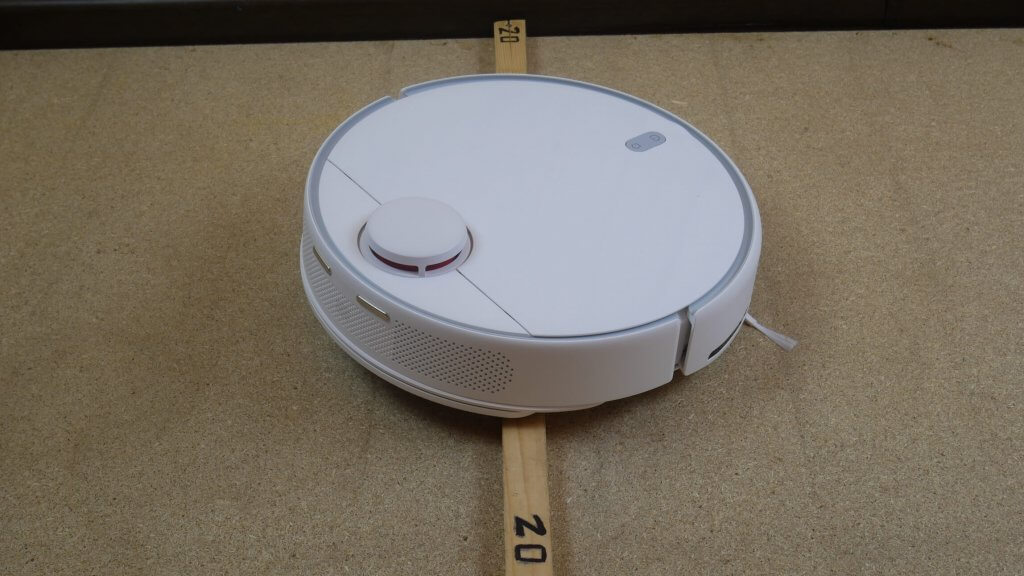
Passage of dark surfaces
Well, one more plus – the robot vacuum cleaner is not afraid of dark coatings, unlike most robots of the Xiaomi family.
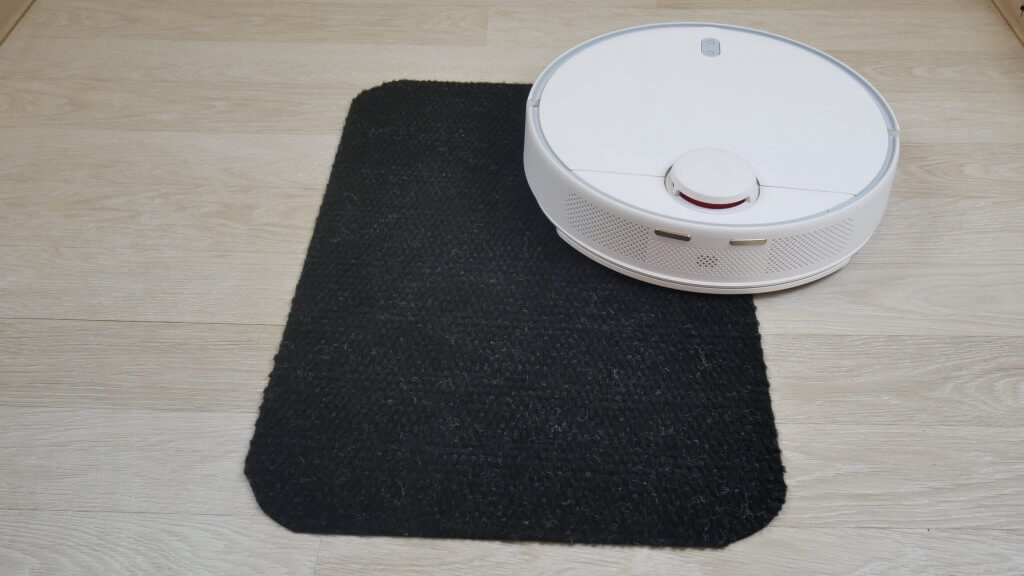
Noise level
In the “Quiet” mode, the noise level is in the range of 59-62 dB. In standard mode, it reaches 63.5 dB. In medium mode, the noise level rises to 66 dB, and at maximum power, the peak value was 69.3 dB. The noise level is increased, given the weak suction power. And it’s not very good.
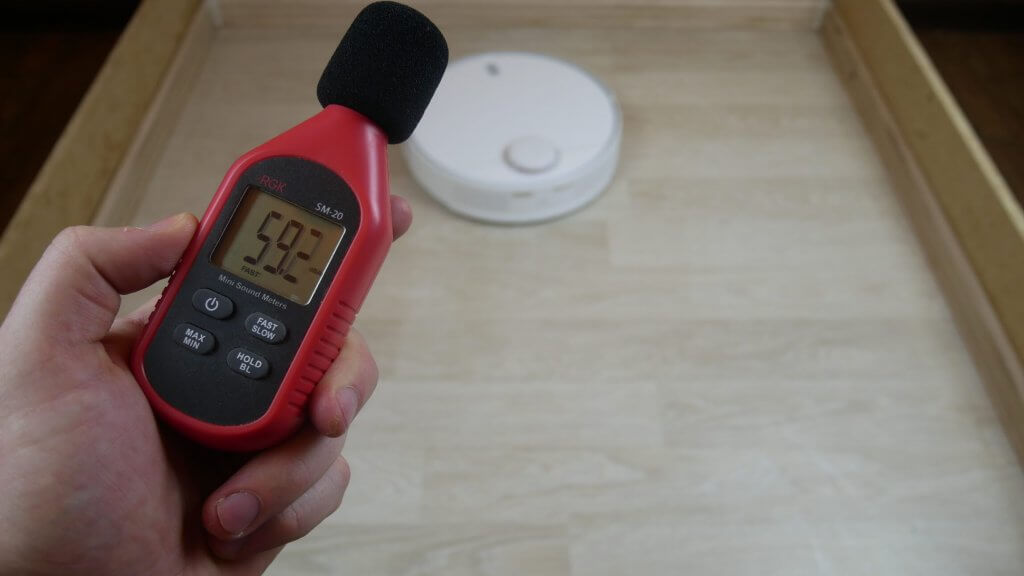
Some Observations
Well, I will share some observations that I found during testing.
First, the Mijia Self-Cleaning Robot Vacuum-Mop does not clean a wide enough area along the plinth.
Secondly, robot is able to clean carpets in a herringbone moves, while lifting a mopping pad. The main thing is to turn on the professional wet cleaning mode in the settings. This is certainly an interesting solution that will slightly improve the quality of cleaning on carpets. But the cleaning time will also increase.
Well, and the third – about 200 ml of water is consumed on one rinse of the mopping pad, but this is not exact value. Sometimes it takes 150 ml, and sometimes 220-230. In general, it is not clear how the different consumption is justified.
Well, it takes about 2 minutes to rinse the mopping pad itself, maybe it was interesting for someone to know.
Summing up
Xiaomi Mijia Self-Cleaning Sweeping Mopping Robot MJSTP was reviewed and tested in detail. According to our rating system, it managed to score 73 out of 100 points. The result is good, but obviously I expected more from this model. For example, the same imperfect Dreame Bot W10 was able to score 79 points out of 100. In this regard, Xiaomi did not even reach it, which was caused by a number of comments. I mentioned it below.
The overall rating of models that passed the Robotobzor test https://robotobzor.com/ratings/general-rating-of-robot-vacuum-cleaners.html.
What I liked:
- Having a mopping pad rinse station that does its job effectively.
- Simultaneous dry and wet cleaning.
- The robot vacuum cleaner is able to lift up a mopping pad when driving on carpets. This makes it very practical and versatile.
- Good navigation.
- High-quality dry cleaning on hard surfaces.
- Good possibility of obstacles.
- The robot vacuum cleaner is not afraid of dark floors.
- Flexible setting of cleaning parameters for each room.
- Very good price, given the availability of the station and the cost of similar robots with a mopping pad rinsing station.
But there are also many disadvantages:
- Not able to scrub off the complex dirt.
- Does not wash along the plinth.
- Low suction power.
- Poor quality of carpet cleaning.
- The robot is designed for the Chinese market, therefore it works on Chinese servers, the application slows down, instructions and voice alerts are only in Chinese.
- Poor quality carpet cleaning.
- Small capacity of the dust collector.
- You can not adjust the frequency of rinsing the mopping pad.
- It is inconvenient to maintain a platform that does not detach for washing when dirt accumulates.
As a result, I have a large number of comments on Xiaomi Mijia Self-Cleaning Sweeping Mopping Robot MJSTP, some of which are still significant. Yes, of course, in some moments it can be even more interesting than the Roborock S7 with a classic self-cleaning station for dry debris. Especially if you prioritize a robot vacuum cleaner for wet cleaning over large areas. But I can’t call it one of the best in its class. If it would at least clean the carpets well, or wiped the dirt well. At least one of the two was it strength – then yes. All the results are pretty standard and it didn’t stand out for me with something special.
The price is very captivating and the robot will fit to maintain cleanliness in the house. Just don’t expect miracles from it. If you have carpets in your house, but you want the robot to vacuum everything, wipe and not wet the carpets, of course, it makes sense to buy it. Since the only analogues are Roborock S7 and Hobot Legee D7, which will soon go on sale. But they don’t have a mopping pad rinse station. Therefore, this solution is optimal for certain conditions.
Here I would like to end this review. If you have any questions, ask them in the comments below. Happy tech shopping! Bye!

